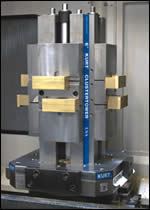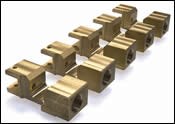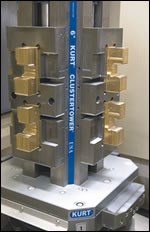Ductile-Iron Towers Provide Needed Clamping Rigidity
Holding 0.001-inch tolerances while machining and removing large amounts of material from a brass part is a challenging task when the job is run at 10,000 revolutions per minute with feed rate of 240 inches per minute.
Share




Holding 0.001-inch tolerances while machining and removing large amounts of material from a brass part is a challenging task when the job is run at 10,000 revolutions per minute with feed rate of 240 inches per minute.
If the workholding isn’t rigid enough, part quality suffers, cutter life is reduced, downtime occurs and operator frustration sets in. It’s a task that requires the rigidity of ductile iron workholding, says Bill Roberts, senior process engineer for Roberts Automatic Products, Chanhassen, Minnesota, a shop that has been in business for more than half a century.
The company has thrived in the high-precision machining business through three generations. Founded in 1947 by Glen Roberts, it specialized early on in complex screw machine parts, CNC turning and machining cell work. With an array of equipment, including large 25/8 Acme-Gridleys, high speed Davenports and Gildemeisters, and precision Mazak and Hitachi Seiki CNCs, the company says it can handle almost any precision machining job.
When tapped holes on the opposite sides of the part wouldn’t align, the company realized that the aluminum towers that were initially used for the project were bending. Roberts Automatic Products found that although aluminum towers offer the advantages of being lightweight and easy to set up, the rigidity for aggressive cuts is limited. Slowing the machine and tightening the clamping stations failed to do the trick, the company adds. It was apparent that the problem was not with the machine, but rather with the actual workholding.
The company then consulted Mike Neeley, a sales representative for Kurt Manufacturing Company (Minneapolis, Minnesota). With his input, the company settled on a pair of Kurt Model CTHDLM644 ClusterTowers, which are constructed of ductile iron. Having now used the vises for years, the company says that even though ductile iron workholding is heavy, it optimizes rigidity, strength and part-holding power.
“We use all types of workholding, including standard vises, towers and dedicated fixturing,” Mr. Roberts says. “Selecting the right workholding can maximize the performance of a machining center.”
The towers are made from 80,000 pounds- per-square-inch of ductile iron, which has 2.5 times the stiffness of aluminum and more vibration damping capabilities, says the manufacturer. Also optimizing production is the PFH 4800 HMC from Mazak Corp. (Florence, Kentucky), which is designed for stability and high accuracy in heavy material removal, according to Roberts Automatic Products.
Mr. Roberts says the challenging job came about when his customer redesigned the part from an aluminum extrusion into a part machined from brass barstock. Machining the parts cost-effectively required high speeds and minimal setup time. The company’s Mazak 4800 proved to be a good fit for this particular job because of its pallet-changing capabilities. The machine can be in the cut continuously on one tower while the operator performs part load/unload operations on the second tower.
As for fit, with two 400-mm by 400-mm pallets, the machining center can handle the two towers with ease, according to the company. This is because the towers have standard square bases that are identical in size to that of the machine pallets. Like the towers, these pallets are made of iron castings. As Mr. Roberts says, “The fact that everything from the tower clamping stations to the floor is solid iron maximizes rigidity.”
Using changeable, ductile iron jaws machined to hold the brass components’ outer dimensions, the company’s tower setup is said to replicate more costly custom fixtures. The machined jaws form a “pocket” into which the parts can be located and clamped quickly. With eight clamping stations on four sides (each holding two parts), the setup takes advantage of the HMC’s fourth axis, which is designed to provide a fast indexing function from one side of the tower to the next.
The two parts on each tower face are positioned within an inch of each other for minimal part-to-part spindle travel, the manufacturer says. The machined jaws clamp on all sides of the parts with 3,772 pounds of clamping force at 40 foot-pounds of input torque. There’s virtually no chance of part misalignment or chatter, even at high speeds. The company also reports that once this particular project is completed, the jaws can be replaced quickly for use in different jobs.
“Part loading and unloading can be carried out in less than 10 seconds per clamping station,” Mr. Roberts explains. “The blank parts position quickly within the jaw plate’s machined pockets. There’s no alignment needed. There’s an A-side and a B-side to each part that is machined sequentially. After the parts are machined, less than half a turn of the two screws at each clamping station releases the part. The next part can then be clamped, thus minimizing wasted operator motion.”
Tower features that enhance the company’s productivity include a clutch design that returns the jaws to the correct clamping position, virtually eliminating timing problems. To prevent chip and coolant buildup, a chipguard system covers the center clamping area at all times. In addition, the towers incorporate the Anglock clamping design, which is said to minimize movable jaw lift.
Read Next
Registration Now Open for the Precision Machining Technology Show (PMTS) 2025
The precision machining industry’s premier event returns to Cleveland, OH, April 1-3.
Read MoreSetting Up the Building Blocks for a Digital Factory
Woodward Inc. spent over a year developing an API to connect machines to its digital factory. Caron Engineering’s MiConnect has cut most of this process while also granting the shop greater access to machine information.
Read MoreBuilding Out a Foundation for Student Machinists
Autodesk and Haas have teamed up to produce an introductory course for students that covers the basics of CAD, CAM and CNC while providing them with a portfolio part.
Read More

























.jpg;maxWidth=300;quality=90)







